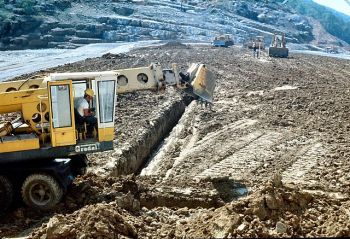Construction: Difference between revisions
No edit summary |
No edit summary |
||
| Line 12: | Line 12: | ||
<!-- Delete any sections that are not necessary to your topic. Add pictures/sections as needed --> | <!-- Delete any sections that are not necessary to your topic. Add pictures/sections as needed --> | ||
" | "The design of an earth or rock-fill dam is a process continued until construction is completed. Much additional information on the characteristics of foundations and abutments is obtained during clearing, stripping, and trenching operations, which may confirm or contradict design assumptions based on earlier geologic studies and subsurface exploration by [[drill]] holes and test pits. Operations in the borrow areas and in required excavations also provide much data pertinent to characteristics of fill material and of excavated slopes. Weather and [[groundwater]] conditions during construction may significantly alter water contents of proposed fill material, or create seepage and/or hydraulic conditions, necessitating modifications in design. Projects must be continuously evaluated and “re-engineered,” as required, during construction, to ensure that the final design is compatible with conditions encountered during construction. Design and design review personnel will make construction site visits to determine whether design modifications are required to meet actual field conditions (see ER 1110-2-112). [[Environmental]] considerations discussed in paragraph 2-5 must be given attention in construction operations. "<ref name="EM2300">[[General Design and Construction Considerations for Earth and Rock-Fill Dams (EM 1110-2-2300) | General Design and Construction Considerations for Earth and Rock-Fill Dams (EM 1110-2-2300), USACE]]</ref> | ||
==Roles and Responsibilities== | ==Roles and Responsibilities== | ||
Revision as of 15:43, 16 December 2022

|
| Construction of an embankment dam. |
"The design of an earth or rock-fill dam is a process continued until construction is completed. Much additional information on the characteristics of foundations and abutments is obtained during clearing, stripping, and trenching operations, which may confirm or contradict design assumptions based on earlier geologic studies and subsurface exploration by drill holes and test pits. Operations in the borrow areas and in required excavations also provide much data pertinent to characteristics of fill material and of excavated slopes. Weather and groundwater conditions during construction may significantly alter water contents of proposed fill material, or create seepage and/or hydraulic conditions, necessitating modifications in design. Projects must be continuously evaluated and “re-engineered,” as required, during construction, to ensure that the final design is compatible with conditions encountered during construction. Design and design review personnel will make construction site visits to determine whether design modifications are required to meet actual field conditions (see ER 1110-2-112). Environmental considerations discussed in paragraph 2-5 must be given attention in construction operations. "[1]
Roles and Responsibilities
Types of Construction Activities
- First Filling
- Care and Diversion of Water
- Dewatering
- Geotechnical Exploration
- Support of Excavation
- Outlet Works Construction
Construction Management Services
Citations:
Revision ID: 5800
Revision Date: 12/16/2022
